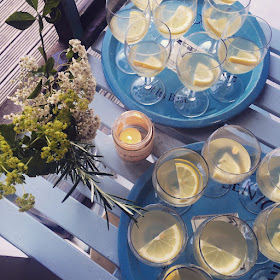At Cook House at the moment we have vinegars infused with pineshoots, cherries, raspberry and black pepper, lovage and parsley, and most recently Eldeflower. I've got a long list of other things that I want to get on the go as they come in to season; full tomato stems on the vine, fennel, nasturtiums, gooseberries, rhubarb...
The Elderflowers are out everywhere at the moment, it seems to be a bumper year as I've spotted their big white blousey flowers waving at me everywhere I go. I have a good spot near Cook House that I pass when I walk down in the mornings so I filled a bag as soon as they appeared.
I've made batches and batches of Elderflower cordial in the past, but wanted to do something a bit more interesting with them this year, and something that I could add to the preserving shelves and use all year round. I'll have to think of something else to do with them too as there are just so many it seems rude not to.
I gave the flower heads a gentle shake to get rid of the tiny black bugs that love them so. Some of these will no doubt get in to the vinegar, but you can strain it through a cloth before you use it and it'll be fine. I went for the most straight forward approach for this vinegar, no heating or additional flavours. Simply fill a jar with flower heads and pour over good quality white wine vinegar. That's it. Give it a bit of a shake to get rid of any air pockets and then leave.
I've been giving it a bit of a swirl everyday and after a week the smell was delicious, really powerful Elderflower, stronger than the vinegar. Sometimes it can smell a bit sickly sweet for me so it works well in vinegar which balances it out. It is great in salad dressings, drinks or a spritz over BBQ'd meat or fish in place of lemon.
I have left the flowers in for two weeks so far and it is smelling and tasting very good. I strained some off to use in a cocktail at Cook House's Spring dinner evening last week (you can see photos here). We served 1 part gin, 2 parts lemon cordial, 1 part Elderflower vinegar and topped up with soda water. It was delicious! The cocktail aspect has definitely got me thinking about what to pop in the next jar of vinegar that might go well with a gin...









